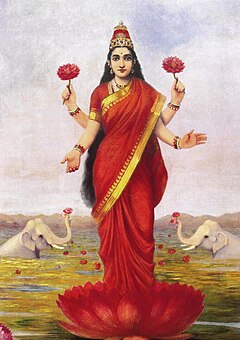Laxmi puja
| Lakshmi Puja | |
|---|---|

Goddess Lakshmi
|
|
| Observed by | Hindus |
| Type | Hindu, Indian people, and Nepalese (Nepali people) |
| Date | Ashvin Amavasya |
| 2017 date | 19 October (Thursday) |
| 2018 date | 7 November |
| 2019 date | 27 October |
| Frequency | annual |
| Related to | Diwali and Tihar |
Lakshmi Puja (Sanskrit: लक्ष्मी पूजा, IAST: Lakṣmī Pūjā), is a Hindu religious festival that falls on Amavasya (new moon day) of Krishna Paksha (Dark fortnight) in the Vikram Samvat Hindu calendar month of Ashwin, on the third day of Tihar and is considered as the main festive day of Deepawali.
According to legend, Lakshmi, the goddess of wealth and Vishnu's wife, visits her devotees and bestows gifts and blessings upon each of them. To welcome the Goddess, devotees clean their houses, decorate them with finery and lights, and prepare sweet treats and delicacies as offerings. Devotees believe the happier Lakshmi is with the visit, the more she blesses the family with health and wealth.
The third day of Diwali is believed to be the most auspicious day; this is when Lakshmi Puja, or the worship of the goddess of wealth is performed. With pomp and ceremony, Lakshmi is invited into the homes of devotees to partake of the gifts that are part of the puja.
Lakshmi is believed to roam the earth on Diwali night. On the evening of Diwali, people open their doors and windows to welcome Lakshmi, and place diya lights on their windowsills and balcony ledges to invite her in.
People wear new clothes or their best outfits as the evening approaches. Then diyas are lit, pujas are offered to Lakshmi, and to one or more additional deities depending on the region of India; typically Ganesha, Saraswati, and Kubera. Lakshmi symbolises wealth and prosperity, and her blessings are invoked for a good year ahead.
On this day, the mothers, who work hard all year, are recognized by the family. Mothers are seen to embody a part of Lakshmi, the good fortune and prosperity of the household. Small earthenware lamps filled with oil are lighted and placed in rows by some Hindus along the parapets of temples and houses. Some set diyas adrift on rivers and streams. Important relationships and friendships are also recognized during the day, by visiting relatives and friends, exchanging gifts and sweets.
...
Wikipedia
